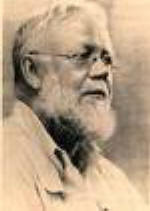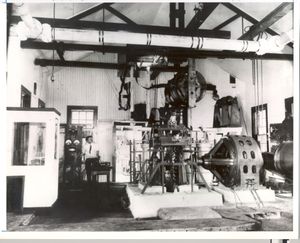Reginald A. Fessenden: Difference between revisions
No edit summary |
No edit summary |
||
| (7 intermediate revisions by 6 users not shown) | |||
| Line 1: | Line 1: | ||
[[Image: | {{Biography | ||
|Image=Fessenden.jpg | |||
|Birthdate=1866/10/06 | |||
|Birthplace=East Bolton, QC, Canada | |||
|Death date=1932/07/22 | |||
|Associated organizations=NESCO | |||
|Fields of study=Radio | |||
}} | |||
[[Image:National Electric Signal Co. Transmitter 0060.jpg|thumb|right|National Electric Signal Co. Transmitter]] | |||
The son of an Episcopal minister, Reginald A. Fessenden was born on 6 October 1866 in East Bolton, Quebec, Canada. A well-known pioneer in [[Radio|radio communications]], Fessenden became a strong advocate of continuous-wave radio as an alternative to spark systems and he opposed excessive government regulation of the emerging industry. A prolific inventor, he introduced a number of important technical innovations and was awarded the [[IEEE Medal of Honor|Medal of Honor of the Institute of Radio Engineers]] in 1921. His Christmas Eve Broadcast has been dedicated an IEEE [[Milestones:First_Wireless_Radio_Broadcast_by_Reginald_A._Fessenden,_1906|Milestone]] in Electrical Engineering and Computing. | |||
Fessenden graduated from Trinity College School and continued his education at Bishop's College while teaching mathematics at Bishop's College School. He then taught for two years at Whitney Institute in Bermuda before moving to New York City in 1886 where he worked as a tester for the Edison Machine Works on electric power distribution systems. In 1887, he joined the research staff at [[Thomas Alva Edison|Edison's]] new laboratory facility in West Orange, NJ, and worked there for about three years. He also worked for the United States Electric Company and for the Stanley Electric Company before accepting an invitation to teach electrical engineering at Purdue University in 1892. The following year, he joined the engineering faculty at the Western University of Pittsburgh where he taught and did research for the next seven years. | |||
Fessenden | Fessenden and some of his more advanced students undertook research relating to wireless communication and he presented a paper on "the possibilities of [[Wireless Telegraphy|wireless telegraphy]]" at a meeting of the [[AIEE History 1884-1963|American Institute of Electrical Engineers]] in November 1899. He also proposed an "electrostatic doublet" theory of atoms in solids and used it in an attempt to link data on atomic volume and spacing to properties of materials such as cohesion and elasticity. In 1900 he published a paper in the Physical Review concerning fundamental theories of matter, electricity, magnetism, and the ether. | ||
Fessenden | Fessenden gave up his academic position in 1900 to accept an offer from the United States Weather Bureau to develop a wireless network for communication with weather stations. It was during this period that he invented the liquid barreter as a wave detector which proved more sensitive and reliable than the [[Coherer|coherer]] detector. The barreter employed a thin platinum wire immersed in a cup of nitric acid as a rectifier of high-frequency signals. Fessenden also conceived the heterodyne radio receiver which employed a local oscillator to mix with incoming signals. | ||
The Weather Bureau project proved unsuccessful but, in 1902, Fessenden persuaded two Pittsburgh financiers to invest in a new firm known as the National Electric Signaling Company (NESCO) to develop wireless communication commercially. The broadcasts from Brant Rock in December 1906 were part of an effort by NESCO to publicize and market the wireless system developed by Fessenden and his assistants. [[Fessenden's Christmas Eve Broadcast|The Christmas Eve]] program as recounted by Fessenden consisted of: | |||
The Weather Bureau project proved unsuccessful but, in 1902, Fessenden persuaded two Pittsburgh financiers to invest in a new firm known as the National Electric Signaling Company (NESCO) to develop wireless communication commercially. The broadcasts from Brant Rock in December 1906 were part of an effort by NESCO to publicize and market the wireless system developed by Fessenden and his assistants. The Christmas Eve program as recounted by Fessenden consisted of: | |||
"... first a short speech by me saying what we were going to do, then some phonograph music.... Then came a violin solo by me ... which I sang one verse of, in addition to playing the violin, though the singing, of course, was not very good. Then came the Bible text, Glory to God in the highest and on earth peace to men of good will, and we finally wound up by wishing them a Merry Christmas and then saying that we proposed to broadcast again on New Year's Eve. " | "... first a short speech by me saying what we were going to do, then some phonograph music.... Then came a violin solo by me ... which I sang one verse of, in addition to playing the violin, though the singing, of course, was not very good. Then came the Bible text, Glory to God in the highest and on earth peace to men of good will, and we finally wound up by wishing them a Merry Christmas and then saying that we proposed to broadcast again on New Year's Eve. " | ||
| Line 17: | Line 23: | ||
Fessenden mentioned that he had been unable to persuade any of his colleagues to play music, sing, or talk and "consequently had to do it all myself." | Fessenden mentioned that he had been unable to persuade any of his colleagues to play music, sing, or talk and "consequently had to do it all myself." | ||
Following disputes over marketing strategy with his financial backers, Fessenden terminated his connection with NESCO in 1911 and it soon went into receivership. He did some consulting work for the Submarine Signal Company during World War I and invented a sonic depth finder. He became involved in protracted patent litigation with the Radio Corporation of America during the | Following disputes over marketing strategy with his financial backers, Fessenden terminated his connection with NESCO in 1911 and it soon went into receivership. He did some consulting work for the Submarine Signal Company during World War I and invented a sonic depth finder. He became involved in protracted patent litigation with the Radio Corporation of America during the 1920s which culminated in an out-of-court settlement which enabled him to retire to Bermuda. Late in life, he became interested in ancient accounts of the lost continent of Atlantis and authored a treatise entitled "The Deluged Civilization of the Caucasus Isthmus." He died on 22 July 1932 at age 65. | ||
{{DEFAULTSORT:Fessenden}} | |||
[[Category:Communications]] | |||
[[Category:Radio communication]] | |||
[[Category:Radio_broadcasting]] | |||
Latest revision as of 17:15, 9 August 2017
- Birthdate
- 1866/10/06
- Birthplace
- East Bolton, QC, Canada
- Death date
- 1932/07/22
- Associated organizations
- NESCO
- Fields of study
- Radio
Biography
The son of an Episcopal minister, Reginald A. Fessenden was born on 6 October 1866 in East Bolton, Quebec, Canada. A well-known pioneer in radio communications, Fessenden became a strong advocate of continuous-wave radio as an alternative to spark systems and he opposed excessive government regulation of the emerging industry. A prolific inventor, he introduced a number of important technical innovations and was awarded the Medal of Honor of the Institute of Radio Engineers in 1921. His Christmas Eve Broadcast has been dedicated an IEEE Milestone in Electrical Engineering and Computing.
Fessenden graduated from Trinity College School and continued his education at Bishop's College while teaching mathematics at Bishop's College School. He then taught for two years at Whitney Institute in Bermuda before moving to New York City in 1886 where he worked as a tester for the Edison Machine Works on electric power distribution systems. In 1887, he joined the research staff at Edison's new laboratory facility in West Orange, NJ, and worked there for about three years. He also worked for the United States Electric Company and for the Stanley Electric Company before accepting an invitation to teach electrical engineering at Purdue University in 1892. The following year, he joined the engineering faculty at the Western University of Pittsburgh where he taught and did research for the next seven years.
Fessenden and some of his more advanced students undertook research relating to wireless communication and he presented a paper on "the possibilities of wireless telegraphy" at a meeting of the American Institute of Electrical Engineers in November 1899. He also proposed an "electrostatic doublet" theory of atoms in solids and used it in an attempt to link data on atomic volume and spacing to properties of materials such as cohesion and elasticity. In 1900 he published a paper in the Physical Review concerning fundamental theories of matter, electricity, magnetism, and the ether.
Fessenden gave up his academic position in 1900 to accept an offer from the United States Weather Bureau to develop a wireless network for communication with weather stations. It was during this period that he invented the liquid barreter as a wave detector which proved more sensitive and reliable than the coherer detector. The barreter employed a thin platinum wire immersed in a cup of nitric acid as a rectifier of high-frequency signals. Fessenden also conceived the heterodyne radio receiver which employed a local oscillator to mix with incoming signals.
The Weather Bureau project proved unsuccessful but, in 1902, Fessenden persuaded two Pittsburgh financiers to invest in a new firm known as the National Electric Signaling Company (NESCO) to develop wireless communication commercially. The broadcasts from Brant Rock in December 1906 were part of an effort by NESCO to publicize and market the wireless system developed by Fessenden and his assistants. The Christmas Eve program as recounted by Fessenden consisted of:
"... first a short speech by me saying what we were going to do, then some phonograph music.... Then came a violin solo by me ... which I sang one verse of, in addition to playing the violin, though the singing, of course, was not very good. Then came the Bible text, Glory to God in the highest and on earth peace to men of good will, and we finally wound up by wishing them a Merry Christmas and then saying that we proposed to broadcast again on New Year's Eve. "
Fessenden mentioned that he had been unable to persuade any of his colleagues to play music, sing, or talk and "consequently had to do it all myself."
Following disputes over marketing strategy with his financial backers, Fessenden terminated his connection with NESCO in 1911 and it soon went into receivership. He did some consulting work for the Submarine Signal Company during World War I and invented a sonic depth finder. He became involved in protracted patent litigation with the Radio Corporation of America during the 1920s which culminated in an out-of-court settlement which enabled him to retire to Bermuda. Late in life, he became interested in ancient accounts of the lost continent of Atlantis and authored a treatise entitled "The Deluged Civilization of the Caucasus Isthmus." He died on 22 July 1932 at age 65.

